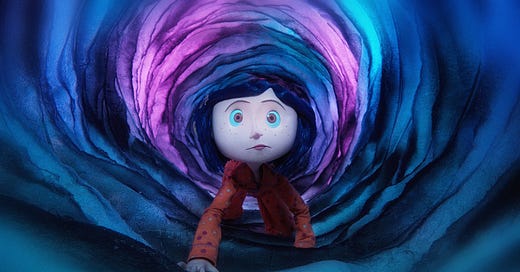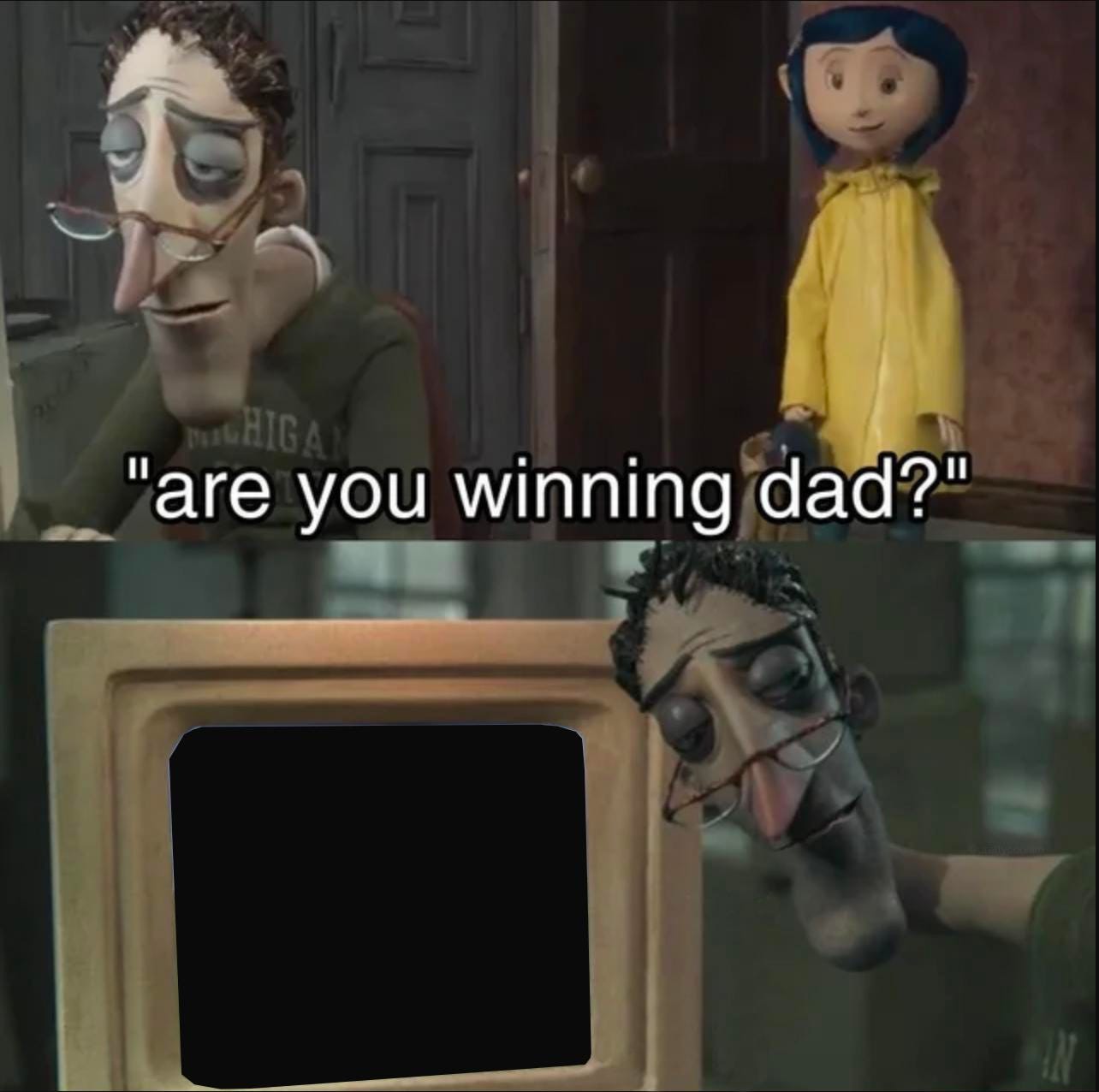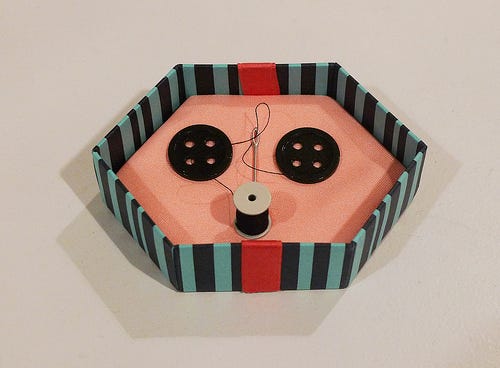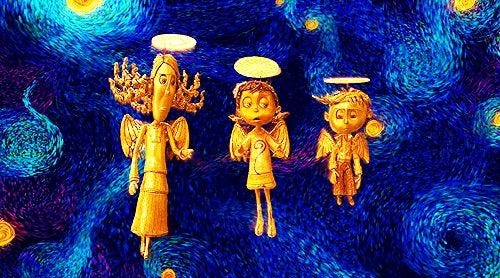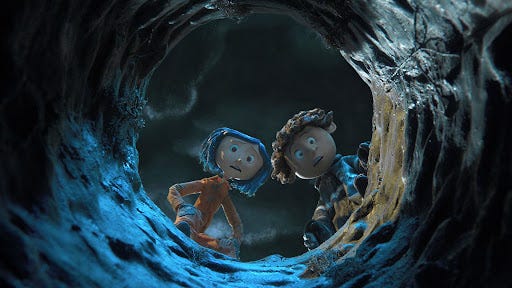This review definitively has spoilers.
Fairly tales are more than true: not because they tell us that dragons exist, but because they tell us that dragons can be beaten. - G.K. Chesterton
Few movies from my childhood stick with me as long as Coraline did.
Perhaps due to its video game-like challenges or its colorful Tim Burton/Guillermo del Toro-like look, Coraline embodied a similar imagination I had as a child. The challenge to collect the eyes like a detective or discover little hiding spots that no one else knew, feels exactly the sort of thing I would do out in the park to keep myself busy. But it felt like Spirited Away, a serious movie with adult undertones, magically real obstacles and genuine questions about life.
And so, with the advent of the 15th anniversary of Coraline, I finally took the time to rewatch this wonderfully creepy movie.
There’s not much I distinctly remember scene-wise from the last time I watched it other than Wybie giving her the cute lookalike doll or Coraline crawling through the tunnel into the “Other” world. What I do remember is how it made me feel — this bonafide ick inside, a fear of never feeling good enough, and a newfound terror around losing my eyes.
This is indicative of what Coraline is trying to do, never straying too far into the realm of inane horror. It walks the line of spookiness that creates a sense of unease, fit to teach a child what a frightening movie could be. Only now, rewatching it as an adult makes me better appreciate its foreshadowing, symbolism, and motifs.
Based on the 2002 novella by Neil Gaiman with the same name, Coraline is a 2009 3D stop-motion animated film directed by Henry Selick (The Nightmare Before Christmas, James and the Giant Peach), following a young girl who discovers an idealized world behind a secret door in her new home. Unlike the original novella, the story is a bit more streamlined, with the addition of a new character and several scenes removed, choosing instead to punch up certain moments in the story and be slightly less horrific.
We’re introduced to Coraline searching for a well, incredibly bored after moving to a new house with no one to play with, her parents clacking away on the computer to complete a gardening catalog, too busy and stressed to spend time with her.
She meets a Black Cat and Wybie, the landlady’s grandson, who gives her an eery ragdoll that looks just like her. The “voodoo” doll leads her to a small door that hides a what seems to be an ordinary brick wall.
But at night, it comes alive as a portal to another alternate universe, one that appears to be the same as her home in the real world; yet, in this space, an alternate set of her parents give Coraline all the attention in the world, cooking the food she wants, and actually listening to what she’s saying. Just like Coraline, I’m transfixed by how wildly animated the dream world is, like an amusement park come to life, the warm and bright colors of a pink wonderland surrounded by the ironically well-curated garden.
She returns to the real world after going to sleep, and meets the rest of her quirky, eccentric neighbors — Mr. Bobinsky, April Spink and Miriam Forcible, and Wybie again. Each has their own peculiar personality, with exaggerated physical appearances and delightful voices. All allude warnings to her in some way about the Other World.
Despite these cautions, Coraline crawls back the next night, enchanted and enamored by her alternate neighbors dream-like vaudeville performance: Other Mr. Bobinsky’s dancing costumed circus mice and Other Ms. Spink and Ms. Forcible’s gymnastics performance with dead black Scottish terriers. She watches each of these with an alternate Wybie, made mute by her Other mother per Caroline’s dislike of real Wybie’s yapping. She also discovers that the Black Cat can traverse worlds like her, and speak in this world, again warning her about the Other Mother.
All of these performances culminate to the big reveal where the Other Mother, or Bedlam, tries to get Coraline to stay forever by sewing black buttons on her eyes.
I remember the first time I saw those buttons. I stayed up all night, staring at the ceiling imagining what would happen if I had buttons, ever so often touching my eye lids to be sure they were there. To be someone else’s playthings and not actually have control over myself. To be unable to act for myself and make my own decisions.
Just like Coraline, the Bedlam’s fear is the same fear many of us have: the fear of being alone. Loneliness is the initial active driver of the story, pushing Caroline to explore more than what the real world has to offer for her. But that same loneliness can become exacerbated, turning parents into controlling predatory monsters with misplaced intentions.
Naturally, Coraline runs back home, only to discover that the Bedlam has captured her parents. She plucks up the courage to return, realizing that she must find some way to challenge the demon. But when she returns, the Other Mother locks the tunnel behind Coraline so she cannot escape.
What follows is a delicate game Coraline proposes to the Bedlam, reclaiming the lost souls for the children who were also victims, evident that two of them are the two missing kids we’ve seen/heard of before — the little white blond boy above the fireplace mantle and the landlady’s missing twin sister. She uses a jade-like planchette, gifted by the old burlesque performers, to find the hidden souls, slowly retracing her steps through the theatre, the cellar, the garden, and finally her new home. As she does so, we watch the fabricated world cave in on itself, powered by these very same souls.
This entire section of the movie felt handmade for a kid like me, making the entire challenge a game of I Spy, dialed up to 100. It’s not often you find a movie in which I believe could have a straight 1:1 to a video game, which now makes me wonder I never bothered to check out the video game.
Coraline escapes back through the portal with a snow-globe trapping her parents, tricking the Bedlam into opening the tunnel, throwing the Black Cat at her face. She frantically crawls through the tunnel, clothing remnants of the lost ghost children scattered along the path, with the Bedlam’s unsettling true-form wirey hand chasing after her.
And so, the next obvious thing I did was read the novella to compare. Starting off strong with already two em-dashes in the first three sentences, it’s a deceptively simple children’s story with simple sentences to read. The form itself seems to capture this sense of loneliness with its spaced out paragraphs contrasted against negative white space.
It makes me appreciate the animation even more. The movie truly does the story justice, bringing to life the words off the page with its the sculpted clay-like figures enhanced by 3D animation. But man, this book is somehow even creepier than the movie.
Distinctly different between the two is the lack of Wybie as a foil character. And while I do believe his addition in the movie makes the film slightly more digestible, he doesn’t seem to add a whole lot more plot-wise. What he does do, is let the audience know that there’s someone else her age out there, who’s alive and can see the world like her.
Caroline evokes the same magical wonder and intimate excitement as many fairy tales do, with an ingenious heroine that challenges a monster of misplaced desire. It has incredible replay-ability, both for its psychological haunting plot and unsettling, beautiful animation.
If you haven’t seen it before, don’t be afraid to check it out.
4.5/5 stars


